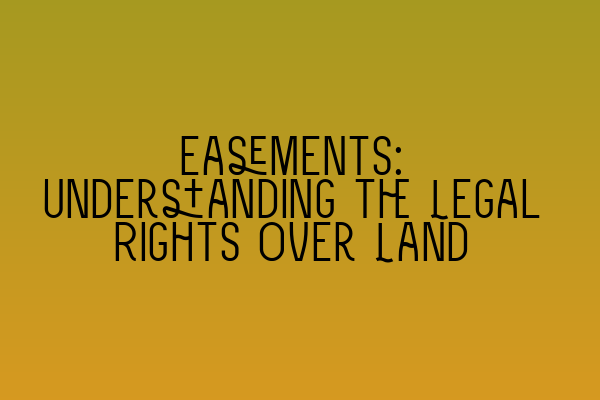Easements: Understanding the Legal Rights Over Land
Welcome to our blog at SQE Property Law & Land Law, where we provide expert insights and guidance on various legal topics. Today, we will discuss easements and dive into understanding the legal rights over land. If you are a property owner or considering purchasing a property, it is crucial to comprehend the concept of easements and how they may impact your property rights.
So, what exactly is an easement? In simple terms, an easement is a legal right that allows someone to use another person’s property for a specific purpose. This right is granted to a person who is not the owner of the property but has a legal interest in it. Easements can be created in various ways, such as through express agreements, implied agreements, or by necessity.
Types of Easements
There are several types of easements, each serving a different purpose. Let’s take a closer look at some common types:
- Right of Way: This type of easement allows an individual or entity to pass through another person’s property, typically for transportation purposes. It could be a pathway, road, or driveway that grants access to an adjoining property or public road.
- Utilities: Utility easements grant utility companies the right to access a property for the purpose of installing and maintaining necessary utility lines, such as electricity, gas, water, and sewerage.
- Air and Light: These easements ensure that a property owner maintains access to non-physical elements like air and light. For example, if a building blocks someone’s view, an easement can be granted to protect the view.
- Drainage: Drainage easements allow for the passage of water through a property, ensuring proper drainage and preventing flooding. This is often crucial in areas with a high water table or where properties are situated on slopes.
- Support: Support easements guarantee that a property owner’s land is supported by neighboring land or structures. This is particularly important for buildings or structures that rely on the stability of adjacent properties.
These are just a few examples of easements that exist. It’s essential to understand the specific type of easement related to your property to comprehend the extent of your rights and obligations.
Creating an Easement
Easements can be created in several ways, depending on the circumstances and the jurisdiction in which the property is located. The most common methods of creating easements include:
- Express Agreement: An easement can be created through a written or verbal agreement between the parties involved. This agreement outlines the rights and obligations of both the property owner and the person benefiting from the easement.
- Implied Agreement: Sometimes, an easement can be implied when the circumstances suggest that the parties intended for a particular use. For example, if a landlocked property can only be accessed by crossing a neighboring property, an easement can be implied by necessity.
- Prior Use: If a certain type of use has been continuously and openly exercised over a specific period, it may establish an easement by prior use. This typically occurs when the use of an easement was present before the properties were severed.
- Prescription: In some cases, an easement can be acquired through prescription, which is similar to adverse possession. If someone has been using another person’s property openly, continuously, and without permission for a specified period, they may acquire a prescriptive easement.
It is crucial to seek legal advice when creating or dealing with easements to ensure that all legal requirements are met and that your rights are adequately protected. Our team of property law experts at SQE Property Law & Land Law can provide the guidance you need.
Resolving Easement Disputes
Easement disputes can arise when there are disagreements between the property owner and the person benefiting from the easement. These disputes can be complex and may require legal intervention. It’s essential to understand your rights and obligations to avoid potential conflicts.
If you find yourself in a situation where an easement dispute arises, it is wise to engage in negotiation or alternative dispute resolution methods, such as mediation or arbitration. These processes can help parties find mutually beneficial resolutions without resorting to costly and time-consuming litigation.
However, if negotiation and alternative dispute resolution methods are unsuccessful, litigation may be necessary. In such cases, it is essential to seek legal representation from experienced property law solicitors who can guide you through the process and advocate for your rights.
Conclusion
Easements play a vital role in property law and can significantly impact property owners’ rights and obligations. Understanding the various types of easements and how they are created is essential for property owners and buyers.
If you have any questions or need assistance relating to easements or any other property law matters, our team at SQE Property Law & Land Law is here to help. Contact us today to schedule a consultation with one of our property law solicitors.
Related Articles:
– Understanding Contractual Capacity: Rights and Limitations
– Interactive SQE Mock Tests for Contract Law: Test Your Knowledge
– Join Our SQE Contract Law Webinars: Expert Insights and Guidance
